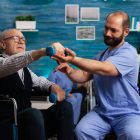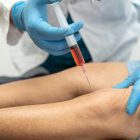Synopsis
A debilitating rotator cuff injury, whether a mild strain or a partial tear, necessitates highly precise and careful therapeutic intervention to restore shoulder stability and power. Expert physiotherapy for rotator cuff injury is the primary non-surgical route to healing, focusing on progressive strengthening and pain reduction. This article explores the benefits of focused physio for rotator cuff protocols, which address the specific mechanics of the tendon complex. Finding a certified shoulder physio is essential for a customized plan, particularly for those also managing associated issues like physio for shoulder bursitis. The integrated approach ensures that all components of the shoulder girdle are addressed, ensuring a complete recovery from the overarching physio for shoulder injury. We also detail how targeted physio for shoulder pain techniques can accelerate relief. Consistent physiotherapy for rotator cuff injury prevents chronic instability. Expert physio for rotator cuff care involves advanced manual therapy and tailored exercises. A dedicated shoulder physio ensures safe loading and functional gains. Meticulous physio for shoulder injury management prevents secondary complications. Specialized physio for shoulder bursitis protocols reduce inflammation. Targeted physio for shoulder pain provides symptomatic relief. Comprehensive physiotherapy for rotator cuff injury is key to restoring power. Trusting expert physio for rotator cuff care ensures long-term stability. A skilled shoulder physio provides the necessary guidance throughout the healing process, managing all aspects of the physio for shoulder injury. Dedicated physio for shoulder bursitis and focused physio for shoulder pain protocols accelerate the return to daily function.
Table of Contents
- The Rotator Cuff- A Complex Powerhouse
- Dedicated Physiotherapy for Rotator Cuff Injury Protocols
- Specialized Physio for Rotator Cuff- The Eccentric Advantage
- The Non-Surgical Path- Managing Physio for Shoulder Injury
- Resolving Associated Inflammation- Physio for Shoulder Bursitis
- The Integrated Role of the Shoulder Physio
- Achieving Durable Relief from Physio for Shoulder Pain
- The Orthocure Advantage- Integrated Shoulder Care Solutions
- Partnering with Orthocure for Complete Shoulder Function
The Rotator Cuff- A Complex Powerhouse
The rotator cuff is a group of four tendons and muscles surrounding the shoulder joint, crucial for both stability and rotational movement. Damage to this cuff, common in athletes and manual laborers, can range from tendonitis (inflammation) to partial or full tears, leading to weakness, pain, and severely limited function, particularly during overhead activities. Because the shoulder is the body’s most mobile joint, its stability relies entirely on the precise, synchronized action of these tendons. Therefore, any compromise to the cuff demands highly specialized and controlled therapeutic intervention focused on restoring structural integrity and power.
Dedicated Physiotherapy for Rotator Cuff Injury Protocols
Effective physiotherapy for rotator cuff injury is a systematic, phased approach essential for healing the damaged tendon and preventing chronic instability. Phase one focuses on protection and pain management, using gentle range-of-motion exercises to maintain joint lubrication without stressing the injured tendon. The critical intermediate phase of physiotherapy for rotator cuff injury involves controlled, specific loading of the tendon to promote collagen alignment and strength. This structured progression, guided by a specialist, is the non-surgical gold standard for achieving a complete and durable recovery.
Specialized Physio for Rotator Cuff- The Eccentric Advantage
The most transformative technique in modern physio for rotator cuff care is eccentric strengthening. This specific exercise modality loads the tendon while the muscle is lengthening, a process scientifically proven to accelerate tendon repair, increase collagen production, and build resilience far more effectively than traditional lifting. Expert physio for rotator cuff protocols utilize resistance bands or light weights, starting with low resistance and progressively increasing the load as the tendon adapts. This precise, controlled loading is what ultimately provides the structural strength necessary to ensure long-term stability and prevent recurrence.
What is the scientific basis for using eccentric exercises for tendons?
The Non-Surgical Path- Managing Physio for Shoulder Injury
Most rotator cuff tears and impingement syndromes can be successfully treated without surgery. A comprehensive physio for shoulder injury program is centered on addressing the root biomechanical issues that caused the injury, such as poor posture or weak scapular (shoulder blade) control. Treatment involves manual techniques to mobilize restricted joints and soft tissues, alongside a dedicated strengthening program. The specialist ensures that the physio for shoulder injury protocol not only heals the tendon but also corrects the structural faults, allowing the shoulder to move optimally without pinching the cuff—a crucial aspect for durability.
Resolving Associated Inflammation- Physio for Shoulder Bursitis
It is common for rotator cuff issues to be accompanied by inflammation, requiring specific intervention for physio for shoulder bursitis . Bursitis typically results from chronic impingement, where the bursa is pinched during overhead movement. Treatment for physio for shoulder bursitis integrates anti-inflammatory modalities (ice, laser) with corrective exercise designed to decompress the subacromial space. By strengthening the muscles that correctly position the shoulder blade (scapular stabilizers), the therapist eliminates the mechanical pinching, resolving the inflammation and providing lasting relief from physio for shoulder pain .
The Integrated Role of the Shoulder Physio
The expertise of a certified shoulder physio is non-negotiable for complex injuries. The specialist acts as the primary guide, ensuring that the patient’s recovery plan is customized and scientifically sound. A skilled shoulder physio performs advanced functional and postural assessments, accurately diagnosing whether the pain originates from the tendon, the bursa, or a nerve, and meticulously guides the progression of strengthening. This expert oversight is crucial to ensure that the loading is challenging enough to stimulate healing but safe enough to prevent re-injury.
Achieving Durable Relief from Physio for Shoulder Pain
Durable relief from chronic physio for shoulder pain is achieved through a structural, not symptomatic, approach. Simply treating the pain provides temporary comfort; fixing the underlying weakness and mechanical faults provides lasting relief. The commitment to specialized physio for shoulder pain protocols involves building muscle endurance and improving posture to support the joint against daily stresses. This ensures that the successful results of physiotherapy for rotator cuff injury are sustained long after the initial discomfort has subsided.
How long does it typically take to restore full rotator cuff strength?
The Orthocure Advantage- Integrated Shoulder Care Solutions
ORTHOCURE CLINICS AND GYMS delivers integrated, specialized care for all shoulder complexities. Our unique 4 Point Protocol ensures that every treatment, from acute physio for shoulder bursitis to rigorous physio for rotator cuff rehabilitation, is standardized, precise, and focused on Structural Correction. We integrate Orthopaedic Doctors, dedicated Physiotherapists, and Chiropractors to manage complex cases collaboratively. This approach leverages advanced technologies, including the MedX, USA machines , which are vital for precisely testing and strengthening the small stabilizing muscles of the cuff, guaranteeing the most durable recovery from physiotherapy for rotator cuff injury .
What makes Orthocure’s care approach unique for shoulder injuries?
Partnering with Orthocure for Complete Shoulder Function
The services offered by ORTHOCURE CLINICS AND GYMS provide a complete pathway to long-term shoulder wellness. We offer expert shoulder physio and specialized physio for shoulder injury protocols, prioritizing non-surgical, evidence-based solutions. The ultimate USP of ORTHOCURE CLINICS AND GYMS is our dedication to Structural Correction over temporary relief. By partnering with Orthocure, you gain access to a protocol-driven pathway that guarantees the highest standard of care, ensuring you overcome chronic physio for shoulder pain and return confidently to a life of unrestricted movement.
What support is available for returning to sport after rotator cuff injury?
FAQs
How does dedicated physiotherapy for rotator cuff injury prevent the need for surgery?
Dedicated physiotherapy for rotator cuff injury prevents surgery by focusing on controlled, progressive tendon loading and strengthening the entire shoulder complex. The specialist uses specific eccentric exercises to promote the healing and alignment of the tendon fibers, rebuilding resilience and power without invasive procedures. This structured approach, overseen by a certified shoulder physio , ensures the tendon is strong enough to stabilize the joint during movement, ultimately eliminating the instability and pain that might otherwise necessitate surgical intervention. This non-surgical path is the preferred gold standard for most partial tendon tears.
What is the main goal of physio for shoulder bursitis and how is it achieved?
The main goal of physio for shoulder bursitis is to reduce acute inflammation and prevent the chronic impingement that caused the bursa to become irritated. It is achieved by combining anti-inflammatory modalities with structural correction. The therapist focuses on manual therapy to restore joint mechanics and prescribes exercises to strengthen the muscles that correctly position the shoulder blade (scapular stabilizers). By improving posture and movement mechanics, the shoulder physio creates more space in the subacromial area, thereby decompressing the bursa and providing long-term relief from physio for shoulder pain .
Why is it essential to address the root cause in a physio for shoulder injury program?
It is essential to address the root cause in a physio for shoulder injury program because the injury itself (like a rotator cuff tear) is often the result of chronic underlying faults, such as poor posture or a weak upper back. Simply healing the tendon provides temporary relief, but the physio for rotator cuff protocol must correct the mechanical fault to prevent the injury from recurring. This focus on structural correction ensures the shoulder is resilient and the pain is durably resolved.
What differentiates a shoulder physio from a general physical therapist for pain management?
A shoulder physio possesses advanced, focused expertise in the complex biomechanics of the shoulder girdle, distinguishing them from a general physical therapist. They are adept at differential diagnosis—determining if the pain is from the cuff, the bursa, or the neck. Their treatment involves high-precision manual mobilization and targeted strengthening protocols that specifically rebuild the small stabilizing muscles. This expertise ensures that the physio for shoulder pain treatment is accurate and addresses the structural complexities unique to the shoulder joint.
How does expert physio for rotator cuff care address the issue of muscle weakness and instability?
Expert physio for rotator cuff care addresses muscle weakness and instability by implementing highly targeted strengthening programs that isolate the four rotator cuff muscles and the key scapular stabilizers. These exercises, prescribed by a shoulder physio , are low-load initially and progress to functional resistance to rebuild muscle endurance and power. This focused approach ensures that the forces stabilizing the shoulder are optimally balanced, which is vital for preventing the instability and compensatory strain that contribute to chronic pain and re-injury, proving essential for effective physiotherapy for rotator cuff injury .
What are the long-term benefits of a successful physio for shoulder bursitis treatment?
The long-term benefits of a successful physio for shoulder bursitis treatment include not only the complete resolution of the inflammation and pain but also structural changes that prevent recurrence. By correcting the underlying postural and scapular muscle imbalances, the treatment eliminates the mechanical impingement that irritates the bursa. This structural correction provides durable relief from physio for shoulder pain and reduces the risk of developing secondary conditions like tendonitis, ensuring the patient can maintain overhead activities without fear of the bursitis returning.
How does the physio for shoulder injury program accelerate the patient's return to sport?
The physio for shoulder injury program accelerates the patient’s return to sport by incorporating sport-specific functional training in the final phase of rehabilitation. After structural integrity is achieved through physio for rotator cuff strengthening, the therapist introduces drills that mimic the patient’s athletic movements (e.g., throwing mechanics or swimming strokes). This ensures that the newly rebuilt strength and stability translate effectively to dynamic, high-demand activities, allowing the athlete a safe and confident return to competition.





